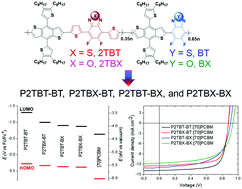Energy level modulation of donor–acceptor alternating random conjugated copolymers for achieving high-performance polymer solar cells†
Abstract
Random copolymerization has been successful in synthesizing conjugated polymers for application in polymer solar cells (PSCs). However, fine energy level modulation without negatively affecting other properties such as optical, electrical, and morphological properties is challenging for random copolymers. In this work, a set of random conjugated copolymers (named P2TBT-BT, P2TBX-BT, P2TBT-BX, and P2TBX-BX) with minor structural changes have been synthesized by replacing the difluorobenzo[2,1,3]thiadiazole (BT) unit with its difluorobenzoxadiazole (BX) analog. The four random conjugated copolymers show desirable similarities in optical, charge transport, and morphological properties, but gradually down-shifted highest occupied molecular orbital (HOMO) and lowest unoccupied molecular orbital (LUMO) levels (P2TBT-BT > P2TBX-BT > P2TBT-BX > P2TBX-BX). When blended with a fullerene-based acceptor ([70]PCBM), a high power conversion efficiency (PCE) of 8.8% was achieved by P2TBT-BT benefitting from the well matched energy level alignment between the polymer donor and fullerene acceptor. This work provides a strategy for energy level modulation of random conjugated copolymers without negatively affecting other properties. Besides, we found that high energetic order can be obtained for random conjugated polymers. These results will provide inspiration for the rational design of new random conjugated copolymers for high-performance PSCs.



 Please wait while we load your content...
Please wait while we load your content...